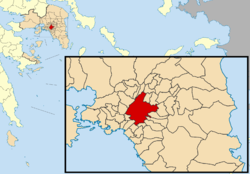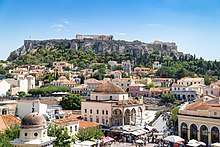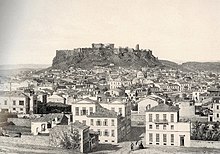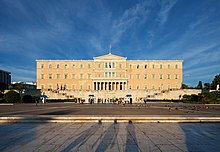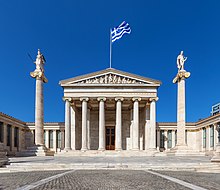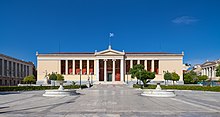Athens
|
Municipality of Athens Δήμος Αθηναίων (Αθήνα) |
||
|---|---|---|
|
|
||
| Basic data | ||
| State : |
|
|
| Region : | Attica | |
| Regional District : | Athens center | |
| Geographic coordinates : | 37 ° 59 ′ N , 23 ° 44 ′ E | |
| Area : | 38.964 km² | |
| Residents : | 664,046 (2011) | |
| Population density : | 17,042.6 inhabitants / km² | |
| Post Code: | 10431-11855, 16121 | |
| Community logo: | ||
| Seat: | Athens | |
| LAU-1 code no .: | 4501 | |
| Districts : | no | |
| Local self-government : |
7 boroughs |
|
| Website: | www.cityofathens.gr | |
| Location in the Attica region | ||
Athens - Neugriechisch Αθήνα [ aθina ] ( .. F sg ), Katharevousa and ancient Greek Ἀθῆναι Athenai ( f pl.. ) - is the capital of Greece . Athens is the most populous and largest city in the country. The municipality of Athens in the center of the metropolitan area of the same name is relatively small. This includes the area of the regional districts of Athens-Center (87.3 km²), Athens-North (138.79 km²), Athens-South (68.9 km²), Athens-West (66.8 km²) and Piraeus (50, 4 km²) with a total of almost 3.1 million inhabitants (2011). The likewise relatively compact agglomeration, the core of which is the municipality of Athens , has approx. 3.8 million inhabitants according to Eurostat, other estimates, however, assume at least 5 million inhabitants due to the lack of registration.
As the country's cultural, historical and economic center, Athens is also the most important metropolis in Greece. The airport is the most important in the country and the port of Piraeus, eight kilometers from the center of Athens, the largest in Greece. From here and from the smaller Rafina , shipping to the numerous Greek islands is also handled. In terms of rail transport, Athens is of national but not international importance.
The city has been continuously settled since the Neolithic Age, making it one of the oldest settlements and cities in Europe. In 1985 Athens became the first European Capital of Culture . In the list of world heritage by UNESCO in 1987 was the Acropolis and 1990, the monastery Daphni added.
Athens was the site of the Attic polis in classical times . In this period (5th century BC. Chr.) Resulting Attic democracy is regarded as the founder of an on the principle of popular sovereignty established political order .
geography
location
Athens is located in the most extensive level of the Attica landscape with the rivers Ilisos and Kifisos and is surrounded on three sides by mountain ranges, the Hymettos (1026 m), the Pentelikon (1107 m), the Parnitha (1413 m) and Aegaleo (468 m) , the fourth side opens to the sea, the Saronic Gulf .
climate
The urban climate of Athens is very special in Greece and also in Europe and was considered to be one of the best in the world before the city developed into a "head of water" that overgrown almost the entire Attic basin and is still dry and largely mild today. The name of Attica goes back to Akt (Greek for “coast” or “promontory”), it is a peninsula.
Quite a few therefore moved to Athens or spent a long time there, for example Sophie de Marbois-Lebrun , who had a villa built on the northern edge of the city and who spent her retirement there. In 1906, Rainer Maria Rilke wrote to Ernst Hardt , who was living in Athens , "to go to Athens for two or three months" to spend the winter there. Walther Judeich wrote in his Topography of Athens in 1931
"On the whole, the climate of Athens seems to have changed as little since ancient times as the image of the landscape."
Josef von Ow wrote in 1854 that both locals and strangers leave the city for a few days in midsummer
"Bring the hottest time in the mountains or on the islands"
Due to the location of Athens, surrounded by mountains in the west, north and east, and the prevailing winds in Greece, the climate in Athens is even drier and warmer than in other regions of the country. Summer temperatures reach over 40 ° C in the shade during hot spells that last three or four days and can occur from June to September. Due to the dense population and the lack of inner-city green spaces, it hardly cools down at night. Temperatures of 25 ° C at midnight are the norm in summer, 30 ° C is not uncommon. The thermometer only falls briefly below 25 ° C towards morning. In winter, on the other hand, there are more frequent ingress of cold air from the north, which can then lead to a blanket of snow at regular intervals, especially in the northern districts. By Central European standards, the November days are still surprisingly warm. While in other southern European cities it already has "winter temperatures", in Athens it is often 20 to 25 ° C a day until mid-November. But spring starts later, and March and April are still surprisingly cool. The mean temperature values in the cold season (December to February) are between 9.6 ° C and 11.4 ° C. Occasionally there are also frost days with temperatures as low as −5 ° C. In the warm season (May to September) the average temperature ranges between 20.5 ° C and 29 ° C. In Athens there are over 2800 hours of sunshine and no less than 348 sunny days per year . On some days sand and dust blow from the Sahara as far as Athens and cover the streets.
Overall, the annual rainfall of 402 mm per year in Athens remains at a very low level. Most of the precipitation falls from late October to early February. The summer months June to September prove to be particularly low in precipitation.
| Athens | ||||||||||||||||||||||||||||||||||||||||||||||||
|---|---|---|---|---|---|---|---|---|---|---|---|---|---|---|---|---|---|---|---|---|---|---|---|---|---|---|---|---|---|---|---|---|---|---|---|---|---|---|---|---|---|---|---|---|---|---|---|---|
| Climate diagram | ||||||||||||||||||||||||||||||||||||||||||||||||
| ||||||||||||||||||||||||||||||||||||||||||||||||
|
Average monthly temperatures and rainfall for Athens
|
|||||||||||||||||||||||||||||||||||||||||||||||||||||||||||||||||||||||||||||||||||||||||||||||||||||||||||||||||||||||||||||||||||||||||||||||||||||||||||||||||||||||||||||||||||||||||||||||||||
The industrialization and urbanization of the Attica peninsula , on which Athens is located, as well as increasing individual traffic since the 1950s have led to an increasing pollution of the air, above all from smoke and sulfur dioxide . The high-pressure weather situation typical of the region with a high risk of inversion ( summer smog ) led to the formation of smog ( Greek το νέφος , to nefos, “the cloud”).
Although measures to reduce air pollution were taken as early as the 1970s , it increased because of the rise in mass motorization as a result of the economic boom in the 1970s and 1980s. The situation came to a head in 1987, when numerous people were killed by smog and the press reported increasing damage to ancient monuments. The authorities reacted with sometimes drastic measures. In order to reduce the volume of traffic, since 1981 there has been a daily change for cars with even or odd car numbers on weekdays from 6:30 a.m. to 4:00 p.m. entry into the city center with strict exceptions for doctors, journalists and tourists.
Far-reaching measures by the authorities and the expansion of local public transport have shown success since the 1990s and have reduced air pollution. However, on very hot days, especially before the holiday season, air pollution is still an issue. The Greek Ministry of the Environment publishes the current air readings for Athens on its website every day.
City structure
The old Athens of the 18th century comprises roughly the districts south and north of the Acropolis, the extension to the east and northeast (Syntagma to Omonia) has been the center of the city since the 19th century .
Although the inhabitants of the Attica peninsula see themselves as Athenians, the city of Athens is administratively limited to an area of less than one million inhabitants.
Founding myths and naming
According to legend, the goddess Athena and the sea god Poseidon vied for the favor of the inhabitants of the then nameless city. Both were supposed to give the residents a present - whoever gave the city the most beautiful present was to be chosen as the namesake. The competition, which has been handed down many times over, can be found among others with Herodotus , in the library of Apollodorus , with Pausanias and Plutarch . Poseidon gave the city a well or a spring, which he opened with his trident, but from which only salt water gushed. At Ovid's he gave the city a horse. Athene's gift was an olive tree. He donated food, olive oil and wood. Athena won and the city was named after her.
According to tradition, Athens was founded by King Kekrops , which is why Kekropia ( Κεκροπία ) is an ancient name of Athens.
The name Athens was always in the plural (Athēnai), but since the 1960s at the latest, the singular form (Athína) has prevailed in Greek, and the plural form is still officially used today. In most languages, Athens is still represented in the plural.
history
The settlement history of the area of the city of Athens goes back about 7500 years to the Neolithic Age . Around 1300 BC A Mycenaean palace was built on the Acropolis . The oldest city complex was limited to the upper surface of a steep rocky hill, accessible only from the west, which later formed the military and religious center of Athens as a castle ( acropolis ). The area was leveled very early on and surrounded with a strong wall, which was secured with nine gates arranged one behind the other ( Enneapylai ). This system was called by the Pelasgians , which was attributed to the construction, Pelargikon . The ancient kings of this part of Attica lived within this castle. For its residents, Athens has always been under the special protection of Zeus , to whom an early altar was dedicated, as well as the city-protecting Athene ( Athene Polias ), who was also dedicated to the city's oldest temple, Hekatompedos . Opposite the outer city gate was the city's oldest market, the Agora .
The legendary King Theseus is credited with uniting the various parts of the Attica landscape into a polis . From then on Athens was the largest Greek city-state in terms of area ( apart from the special case of Sparta ). The memory of this so-called Synoikismos of Theseus may also be based on the creation of a Mycenaean palace center, from which from the 14th century BC onwards. Large parts of Attica were controlled and administered, whereby regional princes lost power.
Very similar developments took place at the beginning of the Mycenaean palace period in other regions, where powerful palace centers also emerged, e.g. B. in Argolis , Messenia and Boeotia .
Athens reached the height of its political and cultural influence as an Attic democracy and leading power in the Attic League during the 5th and 4th centuries BC. BC (classical period). Even when the city of 86 BC When it was incorporated into the Roman Empire , it retained its status as an intellectual center and reached the height of its urban development in the 2nd century AD. During the imperial crisis of the 3rd century , Athens was conquered and sacked by the Germanic Herulians in 267 , but recovered the city and remained important in late antiquity . This changed only after the year 529 n. Chr., When the last philosophical schools on the instructions of the Eastern Roman Emperor Justinian I were closed. The incursions of the Slavs ended the ancient phase of the city's history in the late 6th century; a "dark time" followed.
It was not until the 9th century that the city became a bishopric with the Parthenon as an episcopal church. Athens became a Frankish duchy in the Fourth Crusade (1204) after the capture of Constantinople , after the invasion of the Catalan Company the rule of the Florentines (1388 and 1402), the Ottomans (1392), the Venetians (1395) followed. After the fall of Constantinople in 1453, the lower Athens city in 1456 and the strategically important upper city with the Acropolis were conquered by the Ottomans by Sultan Mehmed II General Omar Pasha in 1458 . The Parthenon was converted from a Latin church to an Orthodox church and, in 1460, a mosque. The Erechtheion served the Ottoman commanders as a harem . The city was now becoming less and less important. After several destruction between the 17th century and the 19th century, the city sank to an insignificant provincial town and had little more than 4,000 inhabitants in 1834, when it was raised to the capital of the newly founded Greek Kingdom . The city, which previously had around twice the population, was largely destroyed by the war of freedom. The Turkish garrison on the Acropolis did not leave the city until 1833, three years after the official independence of Greece.
Athens has grown extremely quickly to its present size over the past 150 years. Today, around four million people live in the greater Athens area. The center of Athens around the Syntagma and Omonia squares is still characterized today by the urban development initiated under King Otto I (a Wittelsbacher ) and by representative public buildings in the neoclassical style. The national garden (originally the palace garden), designed by Wittelsbach court gardeners and open to the public only since 1923 , the adjoining park of the Zappeion , which has been donated to the public since 1888, and the "Gesellschaft der Waldfreunde" under the patronage of Queen Sofie (a native of Hohenzollern ) Between 1908 and 1918 the reforestation of the Acropolis rock , the Philopappos or Muse hill and the Lykavittos initially seemed to guarantee an unusually balanced urban development for southern Europe. In 1920 the area of today's Greater Athens had about 453,000 inhabitants. However, an unregulated growth spurt (with numerous densely populated slums) arose at the beginning of the 1920s as a result of the Greco-Turkish War and the mass expulsions of Greeks from Asia Minor , when Greece incorporated eastern Thrace and the province of Smyrna (today Izmir ) in the Treaty of Lausanne. had to give up to Turkey. Over a million Greeks then had to leave their homeland. Many found a new home in Athens.
During the Second World War , Athens was the scene of spectacular resistance actions: Just a few days after the German occupation of Athens on April 26, 1941, Manolis Glezos tore the swastika flag from the Acropolis on May 31, 1941 as a sign of resistance . The famine as a result of the looting by the occupying powers hit the urban population of Athens particularly hard: In the winters of 1941/42 and 1942/43, over 100,000 people died from starvation in the Athens metropolitan area.
The civil war in Greece 1944–1949 also shook the capital. On December 3, 1944, 15 demonstrators were shot and killed by the police during a mass demonstration by the EAM in Syntagma Square. ELAS units attacked police stations and engaged in street fights with British forces .
The period of prosperity and tremendous economic prosperity began in 1952 under a Conservative government. It was triggered by a large-scale road construction program. Between 1950 and 1960, Greece's demographic situation also changed radically: the population migrated from the countryside to the city in search of work and prosperity. This wave of migration worsened the housing situation in the cities dramatically, especially in Athens. But the government was primarily concerned with rebuilding the rural and rather conservative regions that had been destroyed in the civil war, as well as with the building fabric of the Aegean islands, which had been largely destroyed by a severe earthquake in 1950. The housing problem was left to private investors. These developed the system of "Antiparochí" (roughly: consideration). They took over land and compensated the previous owner not with money, but with a certain number of completed apartments. Conversely, many construction companies and builders paid their workers with apartments.
The bitter disputes between left and right between 1961 and 1967 were also fought in the squares and streets of the capital with demonstrations, some of which were violent.
On April 21, 1967, Athens was the scene of the colonels' coup d'état, which marked the beginning of the seven-year Greek military dictatorship , with the collapse of tanks, the ban on going out and mass arrests . In Athens, however, the resistance also manifested itself despite all the repression measures: In November 1968, many thousands of Athenians attended the funeral of Georgios Papandreou . On November 17, 1973, the uprising at the Polytechnic was brutally suppressed. After the collapse of the regime, Konstantinos Karamanlis landed in Athens on the night of July 24, 1974 , was welcomed by a cheering crowd and sworn in as Prime Minister that night.
In the 1980s, Athens experienced an economic boom, which, however, also led to a loss of quality of life, to traffic jams and smog. Since the 1990s, local public transport has therefore been expanded, bus lanes and new pedestrian zones created. After years of heavy traffic due to the neglected infrastructure, the construction measures ( Athens metro , S-Bahn network and Athens-Spangen motorway, etc.) are showing results. Smog and typical traffic chaos have become rare. Nevertheless, there has been a migration to other cities in Greece. One reason for this is the high real estate prices. At the same time, many foreigners move to Greece , mostly settling in Athens. For a long time, typical for Athens was a very personal and small-scale structure in the suburbs, which was described as "village-like".
Since the late 1980s, many foreigners have also found a new home in Athens; Greece, the traditional country of emigration, is often the first point of arrival for migrants and refugees who want to enter the EU and are therefore confronted with all the positive and negative side effects of immigration . The largest community is made up of the Albanians. Others are Russians, Poles, Filipinos, Bangladeshis and Nigerians. A small “ Chinatown ” district was created in Sophokleousstraße / Plateia Theatrou .
Cityscape and architecture
The cityscape is very heterogeneous and includes buildings from all epochs from antiquity to the present.
19th century architecture in Athens
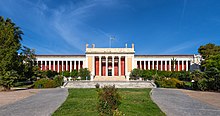
The complex of today's center was built in the 19th century on the basis of the city plan by Eduard Schaubert and Stamatios Kleanthis . A closed cityscape can only be found in the much older Plaka district . Almost all important public buildings such as the theater, the Supreme Court, the Parliament , the Zappeion exhibition hall , the cathedral, the town hall etc. are buildings of classicism. Prominent examples are the “Athens Trilogy” with the National and Kapodistrian University of Athens (1841, design: Hans Christian Hansen ), the National Library and the Academy of Sciences (1891, both by Theophil Hansen ). The Catholic Episcopal Church (design: Leo von Klenze ) and the old eye clinic are in the immediate vicinity . The parliament building (former castle) on Syntagma Square by Friedrich von Gärtner should also be mentioned . Numerous Greeks from abroad settled in Athens in the 19th century, so that numerous villas were built, often designed by Ernst Ziller , who became the court architect of George I and realized over 600 buildings throughout Greece.
20th century architecture in Athens

The architecture of the 19th century in Athens was largely shaped by classicism and the restoration of the Greek state; this continued into the first years of the 20th century. Early Greek modernism was all the more radical. Driven by the housing shortage after the Greeks were expelled from Turkey in 1921, building activity began again. The Athens Charter , the manifesto of modern architecture, was signed in 1933.
To this day, districts such as Kypseli and Exarchia are dominated by apartment houses from the period from 1920 to 1940.
In the period of the late 1940s and early 1960s, luxurious apartment buildings were built in the finer districts of Athens, furnished with all the refinements of the time. They had a concierge, servants' entrance, and large marble-clad entrance halls. The Athenians left the old classicist city villas to move into a coveted, modern apartment. Since these apartments were intended for the upper class, most of them are no smaller than 160 square meters. Such “splendid apartment houses” can be found on Viktoria Square, along Patission Avenue, on the 3rd September street and on the splendid promenade and once the most expensive street in Athens, Mavrommataion Street.
Large public buildings emerged again from the 1960s, such as the East Terminal at the former Athens Hellenikón Airport by Eero Saarinen (1960–1963), the US Embassy on Vassilis-Sophias-Avenue by Walter Gropius (1961) or the Athens Hilton (1963). During the time of the junta , for reasons of speculation, many second-class apartment houses were built, which shape the image of some suburbs.
Important traffic and infrastructure structures have been realized since the 1980s, including the Athens Olympic Sports Complex by Santiago Calatrava and the New Acropolis Museum by Bernard Tschumi (2001–2007, opening 2009). Also worth mentioning are the numerous subway stations and related structures such as the pedestrian bridge at the Katechaki station by Santiago Calatrava.
In general, the construction of landmarks or conspicuous solitary buildings is not allowed in order not to endanger the prominent position of the Acropolis in the cityscape of Athens. Few exceptions were granted during the junta period, but only relatively far from the center. Exceptions include the Athens Tower or the President Hotel in the Ambelokipi district.
Sights and museums
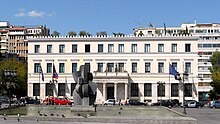


Sights (selection)
The "Emporiko Trigono" (trade triangle) is the center of the city, at one end of which is Syntagma Square . There is the parliament building (formerly the castle) with the national garden (formerly the castle garden), in front of it there is an hourly change of guard of the Evzones in front of the tomb of the unknown soldier (Sunday morning parade). Antique objects that were found during the excavation are on display in the subway station. Close to Syntagma Square is the Kolonaki district, from where a funicular takes you to the Lykavittos (mountain of 277 m in the middle of Athens, excellent view of Athens). The Zappeion and the ancient Kallimarmaro Stadium , rebuilt for the Olympic Games in 1896, are located south of the National Garden .
If you follow Panepistimiou Street, you come to the Athens Trilogy (classical building ensemble) consisting of the academy, library and (old) university, as well as the Catholic Episcopal Church and old eye clinic right next to it .
From Syntagma Square to the west of Hermes Street, one encounters the Central Byzantine Kapnikarea Church , and nearby the Athens Market Hall and the Athens City Hall . Also to the west is Plaka , the former old town, which is located near Monastiraki Square. From there the Agora , the Roman Agora with the Tower of the Winds and Hadrian's Library as well as the Kerameikos can be reached.
The Acropolis , the Acropolis Museum and the Odeon of Herodes Atticus are located to the southwest, to the south the Hadrian's Gate and the Olympieion .
Outside the city are the Daphni Monastery (11th century, with Byzantine mosaics) and the Kaisariani Monastery .
Museums (selection)
As a metropolis, Athens has numerous general and specialized museums. The National Archaeological Museum and the Acropolis Museum are the best-visited because of their importance; likewise with a historical-chronological orientation the Museum of Cycladic Art (the Goulandris Museum), the Benaki Museum and the Byzantine Museum and the Museum of the City of Athens (with a model of the city in 1842 and the first throne room of King Otto).
Larger art museums include the National Gallery (and the National Glyptotheque branch), the Athens Municipal Gallery , the Frissiras Museum of Contemporary European Painting and the DESTE Art Foundation . Specialty museums include the War Museum , the Hellenic Motor Museum , the Museum of Greek Theater , the Numismatic Museum , the Jewish Museum of Greece . Outside Athens, in Palio Faliro, the Trokadero Marina ship museum with the last surviving armored cruiser and the faithful replica of a trireme is worth mentioning.
Culture and art
As a metropolis, Athens has a rich cultural offer, which is continued in the nightlife typical of Greece. The Athens Festival (the Epidavros and Athens Festival) has been held annually since 1955 between May and October , the two ancient theaters being the most important stages. In addition to the state national theater, Athens has a large number of theaters that are privately operated and are financed exclusively by sponsors and entrance fees.
Some public institutions are:
- the Megaro Mousikis concert hall ,
- the National Theater (main building is being rebuilt, performances take place in alternative stages)
- the Iródion (Herodes Atticus Theater, ancient Roman theater and main venue of the Athens Festival)
- the theater on the Lykavittos.
- the Greek National Library and the National Greek Opera in the Stavros Niarchos Foundation Cultural Center, completed in 2016
Athens has also inspired numerous foreign artists throughout history. The “ Attic light ” is a metaphor for the free spirit of the ancient culture that Athens embodies.
Every two years in autumn the Athens Biennale takes place which shows contemporary art. In 2017 Athens, next to Kassel , will be the venue for Documenta 14 .
Art collectors such as Antonis Benakis , George Costakis , Iris Clert , George Economou , Alexander Iolas , Dakis Joannou and Stavros Niarchos were or still are related to Athens .
In a ranking of cities according to their quality of life, Athens ranked 86th out of 231 cities worldwide in 2018.
economy
According to a study from 2014, the greater Athens area generated a gross domestic product of 129.62 billion US dollars in purchasing power parity . In the ranking of the economically strongest metropolitan regions worldwide, he came 102nd. The GDP per capita was $ 32,484 (PPP).
Athens is also economically the most important metropolis in the country , ahead of Thessaloniki . Numerous companies, mostly in the service sector, have their headquarters or large branches in the city. The former commercial center "Emporiko Trigono" (the city center) has lost its importance in favor of suburbs like Paradissos Amarousssiou , where pharmaceutical companies and company headquarters, for example, have moved. Merchant shipping, which is important for Greece, can be found in the neighboring city of Piraeus, although the company headquarters are often located in tax havens.
Important companies in the metropolitan area include, for example, the conglomerate Mytilineos Holdings , the mining company Viohalco , the global beverage bottler Coca-Cola HBC , the building materials manufacturer Titan Cement and the Marfin Investment Group . The 20 largest companies on the Athens Stock Exchange are listed in the FTSE / Athex 20 .
Athens has lost its importance as a manufacturing location, but around 50 percent of Greece's industrial companies are still based in the metropolitan area. Pottery (such as the Keramikos works) and the textile industry were traditionally important, both of which have long since become meaningless. Well-known products from the Athens area are Fage yoghurt, Metaxa brandy, ION chocolate and Korres natural cosmetics .
Athens has around 6 million foreign visitors in 2005, so tourism is an important source of income. The number of foreign visitors has increased steadily over the past few years, which has also resulted in the opening of numerous new accommodations and hotels. The number of visitors from the Far East, especially China, is also growing rapidly.
science and education
Scientists from all parts of the ancient world came to Athens in classical times, and this was encouraged by the latter. A distinction was made between Xenoi and Metöken , with the former denoting the people who spent a short study period, the latter living permanently in the city and enjoying civil rights , including philosophers and doctors such as Anaxagoras from Klazomenai, Protagoras from Abdera and Hippocrates from Kos.
In Roman times, Athens was a popular place to study. Archaeologists and art historians came to Athens in the 18th century and spent long periods researching the ancient world. With the establishment of the Kingdom of Greece , the first two universities in the country were founded, previously there was only the Ionian Academy on Corfu.
With the exception of branches of English and American universities that run an Athens campus , Greek is the only language of instruction, and studying by foreigners in Athens is the exception. However, there are 17 foreign archaeological institutes in Athens .
In Athens have their seat:
- Athens Conservatory
- Research facility National Hellenic Research Foundation (Ethniko Idryma Erevnon)
- Harokopio University of Athens
- Agricultural University of Athens
- National and Kapodistrian University of Athens (founded 1837)
- National Technical University of Athens (Politechneíon; 1836)
- Panteion University of Athens
- Athens University of Economics and Business
- Technical Training Institute Athens
- Athens School of Fine Arts
- French School Athens
Sports
history
By the 5th century BC In Athens, sport was a domain of the nobility and nouveau riche families. Subsequently, the situation changed and sport increasingly became the leisure activity of the middle class, sometimes also the main occupation of members of the lower class.
In the 4th century BC The great Athens stadium was built in the 3rd century BC and was rebuilt at the end of the 19th century.
Today Athens is home to numerous sports clubs that dominate national events in almost all sports in Greece. The city's sporting figurehead is the most successful club in Greece with over 500 national and international titles and the largest club in Greece with over 20 sports departments, Panathinaikos Athens . Other major clubs are AEK , Panionios and Panellinios . The most popular sports include soccer , basketball and volleyball .
In 1983 the Athens Olympic Stadium was the venue for the final of the European Champions Cup and in 1987 for the Cup winners in football. In 1994 and 2007 the final of the UEFA Champions League took place in Athens .
In 1997, the World Athletics Championships took place in the Athens Olympic Stadium, after the European Athletics Championships were held in the same stadium in 1982 .
The basketball hall of the Olympic sports complex, on the other hand, served as the venue for the Final Four tournament of the ULEB Euroleague in 2007 .
Olympic games

The first modern Olympic Games took place in Athens in 1896 ; ten years later the Olympic Intermediate Games, which were important for the Olympic movement, took place. Athens ran for the 1996 Olympic Games, but only finished second behind Atlanta (USA). A renewed candidacy for the games after that was successful. In 2004 the games of the XXVIII. Olympics held. Measured by the number of TV viewers, the 2004 Summer Olympics were the most successful games to date, not least because of the many historical locations. The marathon began in Marathon , the stadium from 1896 was used, and events were also held in Olympia.
traffic
Although Greece is a central state, there is no traffic alignment towards Athens. Patras is important for ferry traffic, Piraeus as a port in general , and Thessaloniki for rail traffic . Athens has a feeder function in the Peloponnese and to Euboea and central Greece . The Athens International Airport is the largest in the country.
Road traffic
Athens is intersected by two motorways, the A1 motorway north to Thessaloniki and the A8 south-west to Corinth and the Peloponnese. The Attiki Odos is a clasp that connects both highways and ends at the airport . All motorways are privately operated and toll roads.
In the center of Athens, within the zone called Daktylios , the rule applies on particularly hot days that only vehicles with even or odd numbers in their license plates are allowed to pass.
Rail transport

In Athens, the meter-gauge railway in the Peloponnese and the standard-gauge railway in the north ended at two different stations, the Larisa station and the Peloponnese station ( Stathmós Peloponnísou ). The latter was shut down as part of the re-routing and the change to the regular lane, so that today traffic is only handled via the former. The railway line in the north of Greece to Thessaloniki is currently being modernized with route relocations in places and is to be expanded for high-speed operation.
Until the suspension of international passenger traffic by the Greek Railway Organization in February 2011, there were direct trains from Athens to Sofia; Istanbul could be reached with a change in Thessaloniki. International train connections to Sofia, Skopje and Belgrade have been resumed since May 2014, but only from Thessaloniki.
Athens has had an underground system since 1904 , when the Athens-Piraeus railway was relocated and the previous one was electrified and run underground in stages. The Athens Metro consisted of one line (Line 1 or Green Line) and was extended to Kifissia. It was not until the 1990s that the construction of two more lines began, and they went into operation in 2003. In the same year, the OSE introduced a S-Bahn traffic, which is run as a subsidiary Proastiakos . This runs parallel to the subway to the airport. The S-Bahn model proved its worth and was also transferred to other large cities (Thessaloniki, Patras).
In 2004 the new Athens tram was opened, which runs from Syntagma Square to the coast to Piraeus and Voula .
Trolleybuses and omnibuses
In addition to the normal buses, the Athens trolleybus has been operating in the city since July 1954 , and the network has been connected to the neighboring city of Piraeus since 1988. With 366 vehicles on 22 lines, the inter-municipal operation is the largest trolleybus network in the EU. The entire fleet was replaced by 2005. There are four large depots (as of 2006). The Athens bus network connects almost all quarters of the city. A special feature is that the timetables only indicate the departure time at the first stop. There are no departure times for all other stops, as a reliable timetable would not be realistic due to the enormous individual traffic with many traffic jams in Athens. At the stops, only the frequency at which the buses run is indicated, so that you know how long you have to wait for the next bus. There is a night bus network, but with only three lines.
Stand and aerial cable car
In the Kolonaki district, close to the center , a funicular takes you to the Lykavittos .
A cable car leads to the Parnitha with the mountain station, the Athens casino and a once luxurious hotel at an altitude of 1000 m with a magnificent view of Athens.
Shipping
Athens itself is not at the port, Piraeus has always been the port city close to Athens, from there all the important ferry connections to the islands lead, although more and more ferries are docking in Nea Makri. Ferries from Italy to Greece usually stop in Patras (or Igoumenitsa) about 200 km west of Athens.
Water supply and disposal
Drinking water
Athens is believed to be the oldest city that introduced an artificial water supply for its residents.
Although the amount of water from the Kallirrhoë spring was praised, it was by far not enough, despite the existence of numerous cisterns and wells. In ancient Athens, the water from the Hymettos and the Pentelikon (two mountain peaks near the city) was brought in by pipes, part of which has been preserved. The project of an aqueduct and reservoir by the Roman emperor Hadrian in the 2nd century was important. The aqueduct carried water from Penteli Mountain to the reservoir on the southern slope of Lycabettus Hill, from where it was distributed to the city. The reservoir in today's Kolonaki district has been preserved (Dexameni), the remains of the aqueduct can be seen in the suburb of Nea Ionia .
Athens is supplied with water from Lake Marathon, built between 1926 and 1929 , from Lake Yliki in Boeotia (since 1959) and from Mornos Reservoir (since 1981) from Fokida in Central Greece. Water was also taken from the Kifisos to irrigate fields . The Athens water utility EYDAP (Athens Water Supply and Sewerage Company) supplies 4.3 million water customers in the region and operates a water network of 9,500 km.
sewage
The sewage network is 6000 km long and supplies 3.5 million customers. EYDAP was floated on the stock exchange in 1999 and privatization is planned.
For a long time, the wastewater from households and industry was discharged largely untreated into the Saronic Gulf , which led to serious chemical and bacterial pollution. From 1990, the second largest sewage treatment plant in Europe was built on the small island of Psyttalia , with a capacity of one million cubic meters of wastewater per day to dispose of wastewater from the greater Athens area. Most of the wastewater flows to a pumping station on the coast, where it is pumped to the island by nine gigantic Archimedean screw pumps. There the plant provides an initial treatment (filtering, desanding, primary clarification, anaerobic treatment and mechanical dewatering of the sewage sludge ), a secondary biological stage through which organic, environmentally harmful carbon, nitrogen and phosphorus compounds are removed, and, since summer 2004, tertiary treatment, see above that the pollutant load could be reduced by 93 percent and the amount of nitrogen by 80 percent. The sewage treatment plant has thus significantly improved the water quality and the environmental conditions in the Saronic Gulf. It is to be expanded further by 2026. In the near future, the treated wastewater is to be used to irrigate afforested areas in Egaleo.
Personalities
Town twinning
Athens maintains the following cities partnerships :
-
 Athens ( United States )
Athens ( United States ) -
 Barcelona ( Spain )
Barcelona ( Spain ) -
 Beirut ( Lebanon )
Beirut ( Lebanon ) -
 Belgrade ( Serbia )
Belgrade ( Serbia ) -
 Bethlehem ( Palestine )
Bethlehem ( Palestine ) -
 Boston ( United States )
Boston ( United States ) -
 Buenos Aires ( Argentina )
Buenos Aires ( Argentina ) -
 Bucharest ( Romania )
Bucharest ( Romania ) -
 Chicago ( United States )
Chicago ( United States ) -
 Cusco ( Peru )
Cusco ( Peru ) -
 Genoa ( Italy )
Genoa ( Italy ) -
 Havana ( Cuba )
Havana ( Cuba ) -
 Istanbul ( Turkey )
Istanbul ( Turkey ) -
 Yerevan ( Armenia )
Yerevan ( Armenia ) -
 Kiev ( Ukraine )
Kiev ( Ukraine ) -
 Ljubljana ( Slovenia )
Ljubljana ( Slovenia ) -
 Los Angeles ( United States )
Los Angeles ( United States ) -
 Madrid ( Spain )
Madrid ( Spain ) -
 Montreal ( Canada )
Montreal ( Canada ) -
 Moscow ( Russia )
Moscow ( Russia ) -
 Nicosia ( Cyprus )
Nicosia ( Cyprus ) -
 Paris ( France )
Paris ( France ) -
 Philadelphia ( United States )
Philadelphia ( United States ) -
 Prague ( Czech Republic )
Prague ( Czech Republic ) -
 Rabat ( Morocco )
Rabat ( Morocco ) -
 Rome ( Italy )
Rome ( Italy ) -
 Santiago ( Chile )
Santiago ( Chile ) -
 Seoul ( South Korea )
Seoul ( South Korea ) -
 Sofia ( Bulgaria )
Sofia ( Bulgaria ) -
 Tbilisi ( Georgia )
Tbilisi ( Georgia ) -
 Tirana ( Albania )
Tirana ( Albania ) -
 Vinaròs ( Spain )
Vinaròs ( Spain ) -
 Warsaw ( Poland )
Warsaw ( Poland ) -
 Washington, DC ( United States )
Washington, DC ( United States ) -
 Xi'an ( People's Republic of China )
Xi'an ( People's Republic of China )
Athens as a nickname for other cities
The name Athens was used by several cities in German-speaking countries, such as Spree-Athens for Berlin, followed by "Isar-Athens" for Munich, as well as Hamburg, Leipzig and university cities such as Weimar, Jena and Halle.
See also
literature
- Walther Judeich : Topography of Athens. 2nd, completely revised edition, Beck, Munich 1931 ( Handbook of Classical Science , Volumes 3, 2, 2).
- John Travlos : Image dictionary on the topography of ancient Athens. Wasmuth, Tübingen 1971.
- Sotiris Chtouris, Elisabeth Heidenreich, Detlev Ipsen : From wilderness to urban space. On the logic of peripheral urbanization using the example of Athens. Campus-Verlag, Frankfurt / Main 1993, ISBN 3-593-34873-X .
- Robert Schediwy : City images - reflections on the change in architecture and urbanism. Lit, Vienna 2005, ISBN 3-8258-7755-8 , especially p. 16ff.
- Kurt Wachsmuth : Athenai 1a . In: Paulys Realencyclopadie der classischen Antiquity Science (RE). Supplement volume I, Stuttgart 1903, Col. 159-219.
Web links
- Official city portal (English, Greek)
- German Embassy Athens (German, Greek)
- Goethe Institute Athens
- Athens Airport (English, Greek)
- Athens Transport Company website (English, Greek) ( Memento from June 12, 2008 in the Internet Archive )
- Thede Kahl: Athens . In: Encyclopedia of the East of Europe (EEO)
- Aerial photos from Athens
Individual evidence
- ↑ Results of the 2011 census ( Memento from June 27, 2015 in the Internet Archive ) ( MS Excel ; 2.6 MB) Greek Statistical Office (ΕΛ.ΣΤΑΤ)
-
^ Theodoros Ioannidis: Living and living together in the European metropolitan regions of Athens and Berlin. (= Also dissertation University of Kassel 2016) Tectum, Baden-Baden 2017, ISBN 978-3-8288-3904-5 , p. 433.
Urban Agglomerations 2011, United Nations ( Memento from December 22, 2012 in the Internet Archive ) - ↑ EUROSTAT: population of metropolitan areas. Retrieved February 17, 2019 .
- ↑ Athens: city area and population. Retrieved February 17, 2019 .
- ^ J. Seibert: Athens . In: Lexicon of the Old World , Volume 1. Zurich 1965
- ^ Hans Rupprecht Goette, Jürgen Hammerstaedt: The ancient Athens: a literary city guide . P. 11
- ^ Topography of Athens . Volume 3, Part 2, Issue 2, 1931, p. 49
- ↑ Josef von Ow: Notes of a Junker at the Court of Athens , Volume 1, p. 71
- ↑ Many dead . In: Der Spiegel . No. 53 , 1987 ( online ).
- ↑ Prisoners of the Cloud . In: Der Spiegel . No. 23 , 1982 ( online ).
- ^ Website of the Greek Ministry of the Environment with the current air readings from Athens ( Memento from June 25, 2007 in the Internet Archive )
- ↑ Herodotus 8.55; Library of Apollodorus 3,14,1; Pausanias 1,24,5; 1.27.1; Plutarch, Themistocles 19th
- ↑ Ovid, Metamorphoses 6.70 to 82.
- ↑ s. in detail: Hans Lohmann : Kiapha Thiti und der Synoikismos des Theseus. In: Hans Lohmann, Torsten Mattern (Ed.): Attika. Archeology of a “central” cultural landscape. Wiesbaden 2010, pp. 35-46.
- ↑ Birgitta Eder : Reflections on the political geography of the Mycenaean world, or: Arguments for the supra-regional importance of Mycenae in the Late Bronze Age Aegean in: Geographia Antiqua XVIII, 2009, pp. 5–46. - on the political geography of the Mycenaean world, or: Arguments for the supraregional importance of Mycenae in the Late Bronze Age Aegean online
- ↑ Gustav Friedrich Hertzberg: Athens , Halle 1885, p. 228 f
- ↑ Mercer's 2018 Quality of Living Rankings. Retrieved August 18, 2018 .
- ^ Alan Berube, Jesus Leal Trujillo, Tao Ran, and Joseph Parilla: Global Metro Monitor . In: Brookings . January 22, 2015 ( brookings.edu [accessed July 19, 2018]).
- ↑ New hotels build on Athens tourism growth on www.ekathimerini.com, accessed on December 5, 2016
- ^ Greece: crisis in Greek tourism is widening . ( Memento from April 16, 2011 in the Internet Archive ) gtai.de, accessed on April 30, 2011
- ↑ Peter Funke: Athens in Classical Time , p. 63
- ↑ On the sociology of sport . In: Jan Stenger: Poetic Argumentation . Pp. 270-271
- ↑ International access offers. In: Pages of the Greek Railways OSE. Retrieved September 12, 2015 .
- ↑ About urban hydraulic structures of the Hellenes . In: German Archaeological Institute, Volumes 5–6, p. 29
- ↑ antikefan.de: Ancient water supply, accessed September 9, 2011
- ↑ Company website ( memo of December 6, 2011 in the Internet Archive ) accessed September 9, 2011
- ^ Water from Psyttalie for Mount Egaleo . Skai.gr (Greek)
- ↑ Asociation de Agencias de Turismo del Cusco: Ciudades hermanas
- ↑ Christian Fuhrmeister, Birgit Jooss (ed.): I sar / Athens: Greek artists in Munich, German artists in Greece ( online )
- ^ Adolf Socin: Contributions to the history of the German language , p. 423
- ^ Karl Ludwig Michelet: History of the last systems of philosophy in Germany , p. 14
- ↑ When Greece was still vouching for Germany . In: The world


